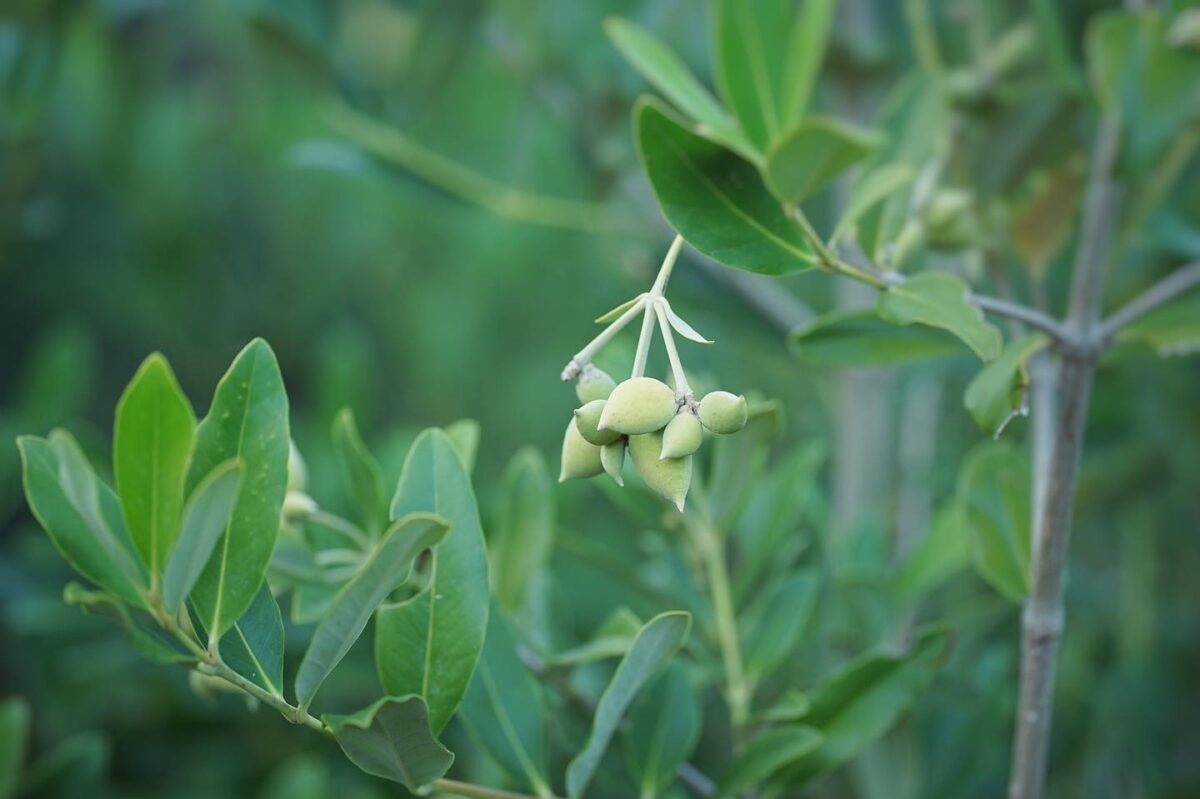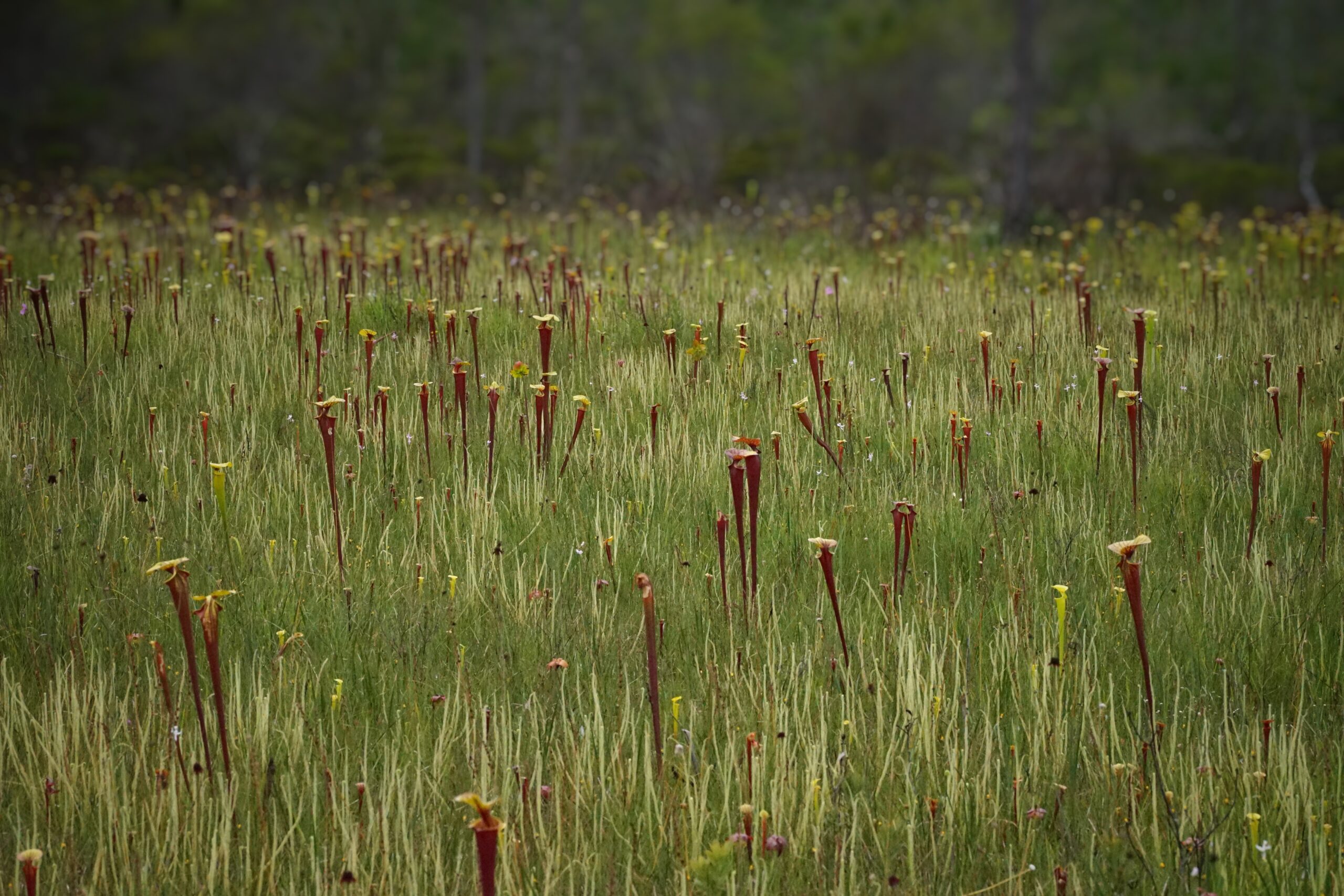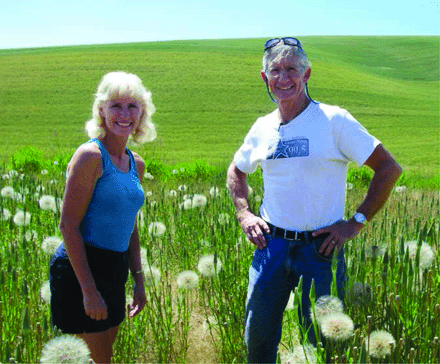Climate Change and Florida’s Native Plants
Pictured above: Pitcher plant bog in the Apalachicola River Basin. Photo by Emily Bell
Florida Climate Week, coordinated by the VoLo Foundation, is October 6-12, 2025.
Climate change refers to long-term changes in climate patterns. While this has occurred naturally throughout Earth’s history, beginning in the 1800s, the burning of fossil fuels by humans has increased exponentially, leading to global warming and other climatic shifts.
Among the contiguous United States, Florida’s low-lying coastal landscape, subtropical climate and continued rapid development makes it particularly vulnerable to the impacts of climate change. This is reflected in more frequent extreme heat days, shifting rainfall patterns, an increase in intense storms and hurricanes, and sea level rise. Additionally, many of Florida’s invasive species will likely benefit from climate change increasing their competitive edge over native biota. This is already being documented with the northward advancement of two of Florida’s most aggressive invasive plants, Brazilian peppertree (Schinus terebinthifolia) and Old world climbing fern (Lygodium microphyllum).
What does this mean for Florida’s plant communities?
From the Apalachicola River Basin in the northwest to the Lake Wales Ridge and into the Everglades, Florida has many unique ecosystems with high biodiversity and endemism. How each of these systems will respond to a rapidly changing climate is likely to be as unique as those environments themselves and require different sets of conservation strategies.
Modeling our potential futures
Scientists are currently looking to the past to model the future and predict potential impacts to plants from climate change. The emerging trends are that species will migrate northward as the climate warms and that Florida’s overall plant diversity will decrease. They have also found that while the suitable habitat of some plants may be significantly reduced, for others — including endangered endemic species like Lake Wales balm (Dicerandra christmanii) — it could actually expand. It’s important to note, however, that a plant’s suitable habitat expanding doesn’t necessarily mean its population will increase. Other factors such as development, invasive species and pathogens could present challenges. These trends toward habitat homogenization and biodiversity declines are already being observed in the Everglades, where rising sea levels are pushing salinity further inland. This shift is displacing more biodiverse freshwater areas and replacing them with harsher environments where few plants can thrive.
Check out our webinar with Drs. Pamela and Douglas Soltis, Using Evolutionary History as a Tool for Plant Conservation, to learn more.
WEBINAR — Using Evolutionary History as a Tool for Plant Conservation
What will Florida’s ecosystems look and feel like in the future? Using herbarium records, scientists can predict how Florida’s native plants will react to our changing climate.
Shifting seasons
In addition to habitat changes, there are serious concerns related to the phenology of plant bloom times and pollinator activity. Scientists and laypersons alike are already beginning to observe changes in the blooming, fruiting and seeding times of plants. In some cases, plants are blooming as much as three weeks earlier than usual, while other species’ bloom times are actually being delayed. Although a shift of one to three weeks may seem inconsequential, these changes may be enough to disrupt the synchronicity of the pollinators that emerge to feed on and facilitate the propagation of plants, as well as the migration of birds that depend on seasonal fruits and play a part in plant distribution.
These issues could prove especially detrimental to the unique relationships of habitat specialists. For example, the rare endemic Blue calamintha bee (Osmia calaminthae) relies on just two known host plants, both of which are equally rare endemic scrub species: Ashe’s calamint (Calamintha ashei) and False rosemary (Conradina brevifolia). Researchers are concerned that warming temperatures could decouple these species’ bloom times from the bee’s late-winter emergence.
Learn more about how changes in phenology are impacting both native and cultivated plants in our four-part phenology series, which includes: When spring arrives too soon, Adjusting to climate changes, Nature’s schedules and Nature’s mismatches – How you can help.
In real-time

While there are many unknowns and much research to still be done, especially in our upland ecosystems, there is no question we are already seeing the impacts of climate change on plant communities in Florida. To date, the most well-studied areas are our coastal ecosystems. The northward expansion of mangroves along both our east and west coasts is fundamentally changing the landscape as researchers work to better understand the implications of mangroves replacing salt marshes. Additionally, sea level rise is causing saltwater inundation to degrade coastal freshwater forests. Finally, in 2024, the first local extinction documented in the U.S. as a direct result of sea level rise was reported from the Florida Keys with the extirpation of the only known population of the Key Largo tree cactus (Pilosocereus millspaughii).
Make a difference!
When faced with a problem as big as climate change, it’s hard not to feel overwhelmed and helpless, but there are some pretty easy and impactful ways that we can all be a part of the solution!
Contribute to the latest science and management decisions — it’s easy to do!
Community science is a powerful tool that helps researchers and natural resource managers see shifts in natural communities. While out exploring the beauty of wild Florida, harness the power of your phone by taking notes and photos to document what you see with iNaturalist. Other great community science programs include EDDMapS for reporting invasive species, and Nature’s Notebook for documenting bloom times and wildlife activity and contributing data to the National Phenology Network.
Create your own oasis for native flora and fauna.
Planting regionally appropriate native plants with a variety of seasonal bloom times beautifies our communities, increases our connection to nature, and supports the local network of plants, pollinators and wildlife. That’s where the Foundation comes in! We’ve got the resources you need to get started with native plants in your own landscape as well as grant programs to bring them to your local schools and communities!
Support land conservation efforts including advocacy for current conservation lands and the acquisition of additional ones.
Healthy intact ecosystems are one of our best and most cost-effective defenses against climate change. They not only help ensure the survival of Florida’s rarest and endemic species, but they buffer our communities from storms, provide flood control and freshwater recharge and store carbon. There are some great organizations in Florida to follow that will help you keep abreast of land conservation issues and advocacy including the Florida Native Plant Society, Florida Wildlife Federation, and 1000 Friends of Florida.
Additional recommended reading: Climate Change Impacts on Florida’s Biodiversity and Ecology


